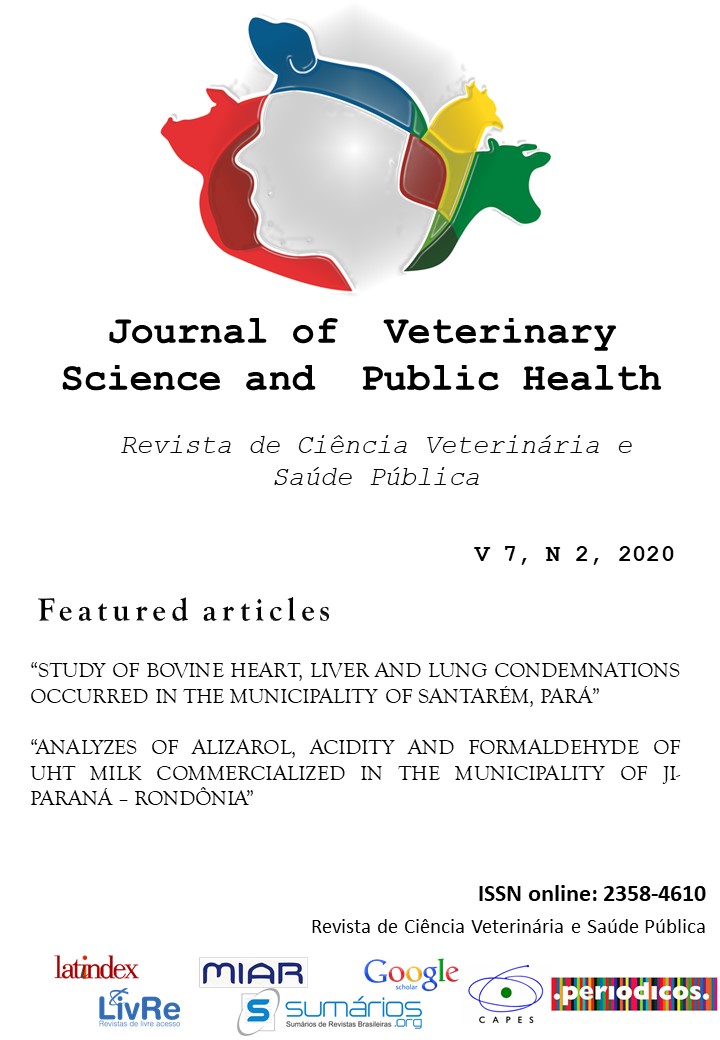BONE MARROW TRANSPLANT IN A DOG WITH BONE MARROW APLASIA SECONDARY TO ERLIQUIOSIS: CASE REPORT
Abstract
A aplasia medular é uma alteração extremamente rara em cães e gatos e tem como principal característica uma medula óssea hipocelular em decorrência do tecido hematopoiético ter sido substituído por células adiposas, acarretando assim em um quadro de pancitopenia sanguínea. Sabe-se que uma das principais causas de aplasia medular é a infecção por Erlichia canis, doença está que em fase crônica causa uma hipoplasia de precursores de todas as linhagens celular e essa anormalidade hematopoiética acarreta em inúmeros problemas para o animal, como letargia, anorexia, perda de peso e fraqueza muscular. Uma vez instalado o quadro de anemia, pode ocorrer também diátese hemorrágica resultante do comprometimento de hemostasia primária (trombocitopenia), assim como predisposição a adquirir infecções secundárias, uma vez que esses pacientes comumente apresentam quadro de leucopenia. O objetivo desse trabalho é relatar o caso de um paciente canino, diagnosticado com aplasia medular subsequente à erliquiose crônica, onde se institui o tratamento com transplante de medula óssea que acarretou em melhora dos valores hematológicos após o procedimento.
Downloads
Riferimenti bibliografici
BRAZZELL, J.L.; WEISS, D.J. A restrospective study of aplastic pancytopenia in the dog: 9 cases (1996-2003). Veterinary Clinical Pathology, v. 35, p. 413-417, 2006
CASTRO.G.C.; GREGIANIN, L.J.; BRUNETTO, A.L.Bone marrow transplantation and cord blood transplantation in children. Jornal de Pediatria, v.77, p.345-360, 2001.
COSTA, A.C.; ALBERNAZ, A.P. Transplante de medula óssea em seres humanos e em cães: Novas perspectivas. Med-vep – Revista científica de Medicina Veterinária – Pequenos animais e animais de estimação, v.8, p.143-149, 2010.
FARIA, J. L. M.; DAGNONE, A.S.; MUNHOZ, T. D.; JOÃO, C. F.; PEREIRA, W. A. B.; MACHADO, R. Z.; TINUCCI-COSTA, M. Ehrlichia canis morulae and DNA detection in whole blood and spleen aspiration samples. Revista Brasileira de Parasitologia Veterinária, v. 19, p.98–102, 2010.
FONSECA, R.B.; SECOLI, S.R. Medicamentos utilizados em transplante de medula óssea: um estudo sobre combinações dos antimicrobianos potencialmente interativos. Revista da Escola de Enfermagem da USP, v.42, p.706-714, 2008.
HARRUS, S.; WANER, T.; AIZENBERG, I.; FOLEI, J.E.; POLAND, A.M.; BARK, H. Amplification of ehrlichial DNA from dogs 34 months after infection with Erlichia canis. Journal of Clinical Microbiology, v.36, p. 73-76, 1998.
HUXSOLL, D.L. Canine Ehrlichiosis (tropical canine pancytopenia): A review. Veterinary Parasitoly, v.2, p.49-60, 1976.
LABRUNA,M.B.; PEREIRA, M.C. Carrapatos em cães no Brasil. Clínica Veterinária, v.30, p.24-32, 2001.
MYLONAKIS, M.E.; SIARKOU, V.; KOUTINAS, A. Myelosuppressive canine monocytic ehrlichiosis (Erlichiacanis): an update on the pathogenesis, diagnosis and management. Israel Journal of Veterinary Medicine, v.65, p.129-135, 2010.
MORAES, L.F.; TAKAHIRA, R.K. Aplasia medular em cães. Revista de ciências agroveterinárias, v.9, p.99-108, 2010.
OLSSON, D.C.; PIPPI, N.L.; MARTINS, D.B.; TOGNOLI, G.K.; SANTOS JR., E.B.; MULLER, D.C.; LOPES, S.; MARCONATO, F.; MORCHBACHER, P.; TEIXEIRA, L. Bone marrow harvest in dogs: Model for acquisition of the total fraction of mononuclears cells. Ciência Rural, v.39, p.141-147, 2009.
SAITO, Taís B. Estudo da erliquiose em cães expostos a carrapatos Rhipicephalus sanguineus experimentalmente infectados. 2009. 127f. Tese (doutorado) – Faculdade de Medicina Veterinária e Zootecnia, Universidade de São Paulo, São Paulo.
THRALL, M.A.; WEISER, G.; ALLISON, R.W.; CAMPBELL, T. W. Hematologia e bioquímica clínica veterinária. 2. Ed. Rio de Janeiro: Guanabara Koogan, 2015.
VECHIATO, C.; SOARES, A.Q.; JANKO, F. Quimioterápicos utilizados no tratamento de pacientes submetidos a transplante de medula óssea, no Hospital Araújo Jorge, no ano de 2004. Revista Eletrônica de Farmácia, v.2, p.214-217, 2005
VIEIRA, R.F.C.; BIONDO, A.W.; GUIMARÃES, A.M.S.; SANTOS, A.P.; SANTOS, R.P.; DUTRA, L.H.; DINIZ, P.P.V.P.; MORAIS, H.A.; MESSICK, J.B.; LABRUNA, M.B.; VIDOTTO,O.Ehrlichiosis in Brazil. Revista Brasileira de Parasitologia Veterinária, v.20, 1-12, 2011.
WAKI, M.F.; MARTORELLI C.R.; MOSKO P.E.; KOGIKA M.M. Classificação em estágios da doença renal crônica em cães e gatos - abordagem clínica, laboratorial e terapêutica. Ciência Rural, v.40, p.2226-2234, 2010.
WANER, T.; HARRYS, S. Canine monocytic ehrlichiosis – from pathology to clinical manifestations. Israel Journal of Veterinay Medicine, v.68, p.8-12, 2013.
WEISS, D. J.; EVANSON, O. A.; BVSC, J. S. A Retrospective Study of Canine Pancytopenia. Veterinary Clinical Pathology, v.28, p.83–88, 1999.
WOODY, B. J.; HOSKINS, J. D. Ehrlichial Diseases of Dogs. Veterinary Clinics of North America: Small Animal Practice, v.21, p.75–98, 1991.








